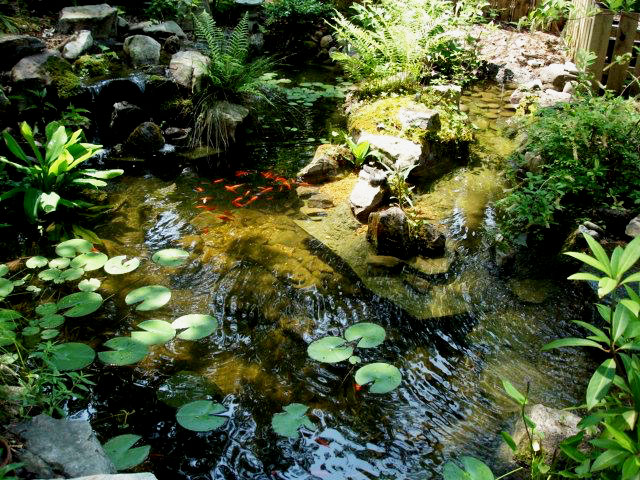Vanessa and Richard Crisler designed a pond in their Betton Hills backyard, not for fish, but for frogs, dragonflies, and other wildlife. It is shallow and includes a sandy, gravelly beach along one edge.
They were shocked when an immature bald eagle perched on a snag above the pond and hung around for half a day. They often have hawks and owls bathing, drinking, and catching frogs, snakes, and other critters using the pond.
At Native Nurseries, I like to hear the sound of the large leopard frogs plopping into the water as I approach the pond in the evening. It is exciting to watch an occasional great egret or great blue heron hunt for fish and frogs in the pond. I even enjoy watching banded water snakes basking in the sun while curled up on a pond plant at the edge of the pond.
People build ponds for lots of reasons; for the tranquil scenery, for the relaxing sound of cascading water, for cultivating prized water lilies or koi, and for providing wildlife habitat. If attracting wildlife to your pond is your goal, planting native pond plants is your means to achieve it. Build habitat and they will come.
Plants serve as food, cover, and habitat for small fish and insects which become part of the food web for other wildlife. In addition, plants are of utmost importance in creating a healthy garden pond.
It is good to incorporate a variety of types of plants in your pond or water garden. There are two categories of underwater plants, submerged and deep-water aquatics. Both survive and thrive with their roots underwater or in permanently saturated soil.
Submerged plants have underwater leaves. Two of the best submerged plants are hornwort and tapegrass. Both provide cover and breeding habitat for fish, frogs and other wildlife. They help oxygenate the pond, releasing oxygen from their leaves as a by-product of photosynthesis. Oxygen passes directly into the water, enabling the water to support other life forms.
This garden pond, planted with all native plants, provides habitat for wildlife.
Hornwort is a free-floating plant and is purchased by the handful and released to float loosely in the pond. Tapegrass, purchased in small pots and placed on the bottom of the pond, is a graceful underwater undulating grass for sun or shade. Both will multiply and need to be thinned periodically.
Deep water aquatic plants have roots and flexible stems which are submerged, but leaves and flowers must float above the water. Good examples are water lilies, which must have sun in order to bloom well.
In addition to providing habitat, underwater plants also absorb nutrients (from pond fish) that are dissolved in water, thereby competing with algae. Probably more important in the control of algae is the shade that water lilies and other plants provide. Good advice is to plant your pond with enough aquatic plants to cover 60 to 80 percent of the pond's surface. However, remember that algae is a fact of life for a water gardener. It cannot be totally eliminated but can be controlled through creating a balanced ecosystem.
Your pond should also contain marginal or edge plants that inhabit shallow water or the edges of a water garden. They provide vertical contrast and cover for birds, aquatic insects, and other small creatures. It is important to position marginals in the depth of water that best suits each individual plant. Most grow quickly; you may need to control growth by isolating them in planting beds or in pots.
Some good examples are lemon bacopa, duck potato or arrowhead, pickerelweed, soft rush, yellow canna lily, powderblue snakeroot, cardinal flower, and blue flag iris. Lemon bacopa is a low growing, mat-forming perennial found on saturated soil or shallowly inundated. It has bright blue flowers in summer and what I love most about it is its lemon scented foliage.
Another favorite is cardinal flower, with its brilliant red flower spikes that hummingbirds visit in summer. This can be planted at the edge of the pond or kept in a clay pot sitting in shallow water. Want butterflies? Plant pickerel weed with its lovely purple blossoms.
Finally, use moisture loving plants around the pond to create habitat and to lightly shade the pond. These are the plants that thrive in moist soil but will not tolerate waterlogged soil. A good example is maidenhair fern. It will accent the rocks around the edges of your pond but will die off if inundated.
All the plants listed in this article are native to Florida. Be very careful with non-native aquatic plants. Some may have the potential to become the next invasive plant, such as hydrilla or water hyacinths, which choke our lakes, rivers, and springs. The worst of our aquatic invasives were introduced as pond plants through the aquarium and nursery industries.




